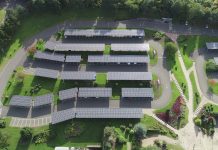Ken-ichi ITAKURA, University Professor at the Muroran Institute of Technology, introduces a project that concerns the current energy situation in Japan and the problems associated with this
Firstly, when it comes to the energy situation in Japan and its associated problems, almost 99% of coal is imported from foreign countries due to the current economic conditions. However, much un-mined coal remains in the country under difficult conditions to mine it out, since the geological conditions here are severe and have many faults. As such, UCG (Underground Coal Gasification) techniques are applicable.
Problems of conventional UCG system
The conventional UCG process has had problems to overcome when applied to the coal seam of Japan.
One of the problems is gas leakage towards the surface through the cracks. Secondly, is subsidence caused by the UCG cavity in the coal seam. A third problem is groundwater contamination. These problems are induced by the fracturing activity during UCG process.
Hybrid UCG (H-UCG)
We have developed a safe, higher gasification efficiency and environmentally friendly UCG system. To solve the above problems caused by the fracturing of coal and rock, we apply acoustic emission/microseismic activity (AE/MS) monitoring techniques to visualise the combustion and gasification reactor and control the fracturing activity using injection agents from the surface.
Key technologies of H-UCG
Higher gasification efficiency
In spite of co-axial type UCG, to retrieve horizontal co-axial UCG achieves higher gasification efficiency which is the same as a conventional UCG system. It is a lower cost system.
A safe and environmentally friendly system
By controlling the fracturing in the coal seam and rocks by AE/MS monitoring during UCG, it is possible to visualise the underground gasification reactor and its safe operation.
Total environmental monitoring
Using the internet, all environmental data is remotely monitored – the air, the ground surface, underground and on groundwater.
Safe and continuous handling of UCG production gas
Discharge plasma units decomposed the production gas continuously, such as hydrogen sulfide.
H-UCG
Woody biomass chips and waste plastic chips are gasified in an underground reactor. These chips are also used to control the temperature of the reactor.
CO2 storage into the UCG cavity
When the process is finished, CO2 gas is stored permanently inside the UCG cavity with a paste mixture. It contributes to the CO2 reduction and supports the UCG cavity.
Benefits of our project
- It provides a local energy source for the energy grid.
- It gives a stable production of power and a thermal energy supply to the local area in an environmentally friendly and safe process.
- It provides a low-cost form of energy production.
- The usage of UCG produced gas has some flexible options to fit in with local needs.
Invitation of sponsors and partners
Now, we are planning the feasibility field experiments to evaluate the technology on safe and efficient gasification efficiency, in an economic way. To realise this field experiment, we are seeking sponsors and partners.
Recent publications
Ken-ichi Itakura, Gota Deguchi, Akihiro Hamanaka, Hidenori Inomata, Fa-qiang Su, Kazuhiro Takahashi, Kohki Satoh, Yukio Hama, Jun-ichi Kodama, Takatyki Sugawara, Alexey Belov: Development of Compact and Higher Efficiency Co-axial UCG Sysytem and Its Trial Experiments, Proc. of 25th World Mining Congress, Astana, Kazakhstan, (2018)
Fa-qiang Sua, Akihiro Hamanaka, Ken-ichi Itakura, Wenyan Zhang, Gota Deguchi, Kohki Sato, Kazuhiro Takahashi, Jun-ichi Kodam: Monitoring and evaluation of simulated underground coal gasification in an ex-situ experimental artificial coal seam system, Applied Energy, 223, 82–92 (2018)
Ken-ichi ItakuraGota Deguchi, Kazuhiro Takahashi, Akihiro Hamanaka, Jun-ichi Kodama: Tapping Japan’s coal resources, Impact-Communicating Research, Science Impact Ltd., December, ISSN 2398-7073, pp.40-42, (2017)
Please note: This is a commercial profile
Ken-ichi Itakura
Specially Appointed Professor
Endowed Research Laboratory of Un-mined Mineral Resources and Energy Engineering
Muroran Institute of Technology
Tel: +81 143 46 5424













